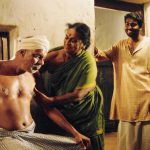Festivals: Venice, Rotterdam, Goteborg, Vienna, Paris, Manosque, Nantes, Fribourg, Ljubljana, Munich, London, New York, Washington DC, Toronto, Shanghai, Fukuoka and Jerusalem among others.
Awards: International Film Critics’ Prize (FIPRESCI) for the Best Film, Mumbai,
National Award for Best Film in Malayalam.
Kerala State Awards for Best Actor, Best Cinematography, Best Editing, Best Sound,
Best Costumes and Best Supporting Actor.
Produced with the support of the ‘Fonds Sud’ Ministere Francaise de la Culture de Centre National de la Cinematographie Ministere des Affaires Etrangeres The Hubert Bals Fund of the International Film Festival Rotterdam The Montecinemaverita Foundation The Swiss Agency for Development and Cooperation The Swiss Federal Department of Foreign Affairs.
The Title
The Story
 is set in pre-independence India of the 1940-s.ln the southern princely State of Travancore (a constituent of present day Kerala), as elsewhere in the country, death by hanging was a prevailing penal practice. The State had its own professional executioner, traditionally the head of a designated family. Settled way out in a border village, he was not to have any direct links or dealings with the mainstream society. In return for the practice of the dreaded profession, the Hangman used to enjoy a few privileges from the royalty – housing, agricultural lands, a yearly allowance and special monetary benefits and gifts for each job done.
is set in pre-independence India of the 1940-s.ln the southern princely State of Travancore (a constituent of present day Kerala), as elsewhere in the country, death by hanging was a prevailing penal practice. The State had its own professional executioner, traditionally the head of a designated family. Settled way out in a border village, he was not to have any direct links or dealings with the mainstream society. In return for the practice of the dreaded profession, the Hangman used to enjoy a few privileges from the royalty – housing, agricultural lands, a yearly allowance and special monetary benefits and gifts for each job done.
The villagers believed the Hangman possessed divine powers of healing derived from the Goddess Kali Herself, and that the ash made from the hangman’s rope was a miracle-medicine.
All the same, nothing could compensate for the haunting sense of guilt that plagued him for life.
As times began to change, the hangings grew increasingly few and far between.
So it is after a long interval – even as the Hangman believed he had put his ghastly vocation behind him that a royal messenger arrives to order an execution afresh.
Director’s Statement
We experience the world through a method of empathy. Empathy is defined as the projection of one’s own personality into another’s in order to understand him or her better. How does one develop a kindred feeling and concern for another of his fellow beings? How does someone else’s agony and pain become your own? How it haunts you, torments you and makes you feel even guilty and remorseful.
Paired down to the essentials, the starting point seems to be the sensitive and humane attitude one is born with but eventually corrupted by the compulsions of everyday life.
The film also raises relevant questions about the idea of responsibility. When man -made laws are not capable of arriving at the truth and tracking down the guilty, when an innocent gets the extreme sentence of capital punishment, who should be held responsible? – The judiciary, the law -makers, the very system of governance or the lone executioner at the end of the line?
I explore here the unknown terrains of the conscious and the unconscious; of the individual and the collective, a search that is at once culture specific as well as universal in relevance.
Review:
‘This near masterpiece from Indian director Adoor Gopalakrishnan is precise in its storytelling and expansive in its evocation of a culture.
Leagues away from India’s all-singing, all-dancing Bollywood movies, “Shadow Kill” is a delicately philosophical film about a regretful state executioner trying to avoid carrying out one last hanging. Although Western audiences’ brief flirtation with serious Indian cinema began and ended with Satyajit Ray, viewers who enjoy works by, for instance, Iran’s Abbas Kiarostami and Taiwan’s Hou Hsiao-hsien should find this an emotional and intellectual delight. “Shadow Kill” played in the Hubert Bals Fund section of Rotterdam’s film festival this year (2003).
“Shadow Kill” is an example of New Malayalam cinema, a regional-language movement from the southwesterly state of Kerala that focuses on social issues. Set in the 1940s, before Gandhi won independence for India, Gopalakrishnan’s tale begins with the aging hangman (Oduvil Unnkrishnan) an innocent man. Then the local ruler’s messenger arrives to inform him that he’s been ordered to carry out another execution.
The executioner spends a worried night with the prisoner’s three guards, who try to distract him with the tale of an innocent young boy who is executed in the place of a rich murderer. It turns out that the young boy is, in fact, the prisoner the executioner has come to hang.
“Shadow Kill” harbors many delights. Gopalakrishnan’s attention to both historical detail and the religious rituals of the executioner allows the film to stand as a document to a time and a place. Structure is exciting and unusual, especially the way the story within a story suddenly becomes the turning point of the plot. Vignettes of local life are seamlessly integrated into the work as a whole. There are also stunning visual moments, as when the white threads on a loom crisscross the screen’.
– Richard James Havis The Hollywood Reporter
Filmmakers and Critics Say
Cahiers du Cinema, France
– Stephane Delorme & Charles Tesson
Film Comment, USA
– Travis Crawford
Cinemascope, Canada
– Steve Gravestock
Credits:
- Story, Script, Dialogue and Direction: Adoor Gopalakrishnan
- Produced by: Adoor Gopalakrishnan Productions
- Co-produced by: Artcam International, Paris
- Cinematography: Ravi Varma, Sunny Joseph
- Music: llayaraja
- Sound Recording: N. Harikumar
- Sound Editing & Mixing: Dominique Vieillard
- Editing: Ajith
- Decor: RatheeshBabu
- Costumes: Satheesh S B
- Make-up: P. N. Mani
- Still Photography: Razakh Kottakkal
- Production Controller: Kettidathii Vijayan
- Production Coordinator: K.N.Shaji
- Chief Assistant: Sajeev Pillai
- Duration: 90 Minutes
- Length: 8363 ft. (2549 Mtrs)
- Color: Eastman
- Format: 35 mm Cinemascope
- Sound: Optical – Mono
- Language: Malayalam
- Country: India-France
- Year of Production: 2002
Cast & characters:
- Oduvil Unnikrishnan (Kaliyappan the Hangman)
- Sukumari (Marakatam, his wife)
- Reeja (Mallika, the younger daughter)
- TharaKalyan (Madhavi the elder daughter)
- Sunil (Muthu, the son)
- Murali (Vasu, Madhavi’s husband)
- Sivakumar (Mallika’s lover)
- Jagathy Sreekumar (the royal messenger)
- Nedumudi Venu (the story-teller jail-warder)
- Vijayaraghavan (Jail warder)
- Aliyar (Jail warder)
- Ravi Vallathol (the landlord)
- Pooappura Radhakrlshnan (the lanlord’s aide)
- Indrans (the barber)
- Cuckoo Parameswaran (the patient)
- Punnapra Appachan (the arrack-shop owner)
- N. K. Gopalakrishnan (the school teacher)
Enquiries
Adoor Gopalakrishnan
Darsanam, Trivandrum – 695 017 Kerala, India.
Ph:+91-471-2551144 Fax:+ 91 -471 -2446567
E-mail: adoor@vsnl.com
Joel Farges
Artcam International
19 rue de Santonge, Paris 75003 *
Ph: + 33 (0) 1 42 71 1675 Fax:+33 (0)1 42 71 1403
E-mail:artcam @ artcam.









